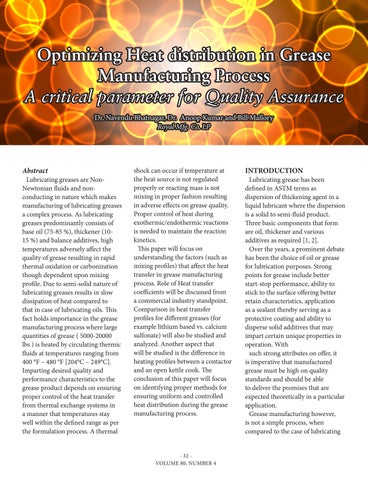Optimizing Heat distribution in Grease Manufacturing Process A critical parameter for Quality Assurance Dr. Navendu Bhatnagar, Dr. Anoop Kumar and Bill Mallory Royal Mfg. Co. LP
Abstract
Lubricating greases are NonNewtonian fluids and nonconducting in nature which makes manufacturing of lubricating greases a complex process. As lubricating greases predominantly consists of base oil (75-85 %), thickener (1015 %) and balance additives, high temperatures adversely affect the quality of grease resulting in rapid thermal oxidation or carbonization though dependent upon mixing profile. Due to semi-solid nature of lubricating greases results in slow dissipation of heat compared to that in case of lubricating oils. This fact holds importance in the grease manufacturing process where large quantities of grease ( 5000-20000 lbs ) is heated by circulating thermic fluids at temperatures ranging from 400 °F – 480 °F [204°C – 249°C]. Imparting desired quality and performance characteristics to the grease product depends on ensuring proper control of the heat transfer from thermal exchange systems in a manner that temperatures stay well within the defined range as per the formulation process. A thermal
shock can occur if temperature at the heat source is not regulated properly or reacting mass is not mixing in proper fashion resulting in adverse effects on grease quality. Proper control of heat during exothermic/endothermic reactions is needed to maintain the reaction kinetics. This paper will focus on understanding the factors (such as mixing profiles) that affect the heat transfer in grease manufacturing process. Role of Heat transfer coefficients will be discussed from a commercial industry standpoint. Comparison in heat transfer profiles for different greases (for example lithium based vs. calcium sulfonate) will also be studied and analyzed. Another aspect that will be studied is the difference in heating profiles between a contactor and an open kettle cook. The conclusion of this paper will focus on identifying proper methods for ensuring uniform and controlled heat distribution during the grease manufacturing process.
- 32 VOLUME 80, NUMBER 4
INTRODUCTION
Lubricating grease has been defined in ASTM terms as dispersion of thickening agent in a liquid lubricant where the dispersion is a solid to semi-fluid product. Three basic components that form are oil, thickener and various additives as required [1, 2]. Over the years, a prominent debate has been the choice of oil or grease for lubrication purposes. Strong points for grease include better start-stop performance, ability to stick to the surface offering better retain characteristics, application as a sealant thereby serving as a protective coating and ability to disperse solid additives that may impart certain unique properties in operation. With such strong attributes on offer, it is imperative that manufactured grease must be high on quality standards and should be able to deliver the promises that are expected theoretically in a particular application. Grease manufacturing however, is not a simple process, when compared to the case of lubricating








